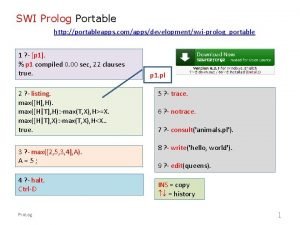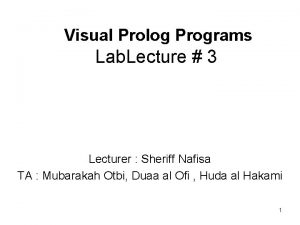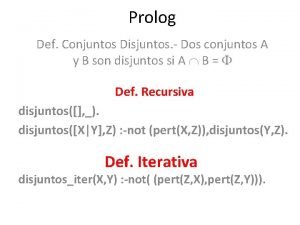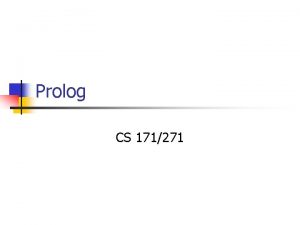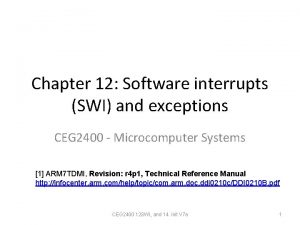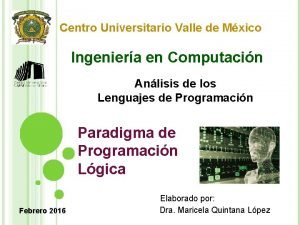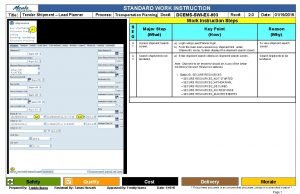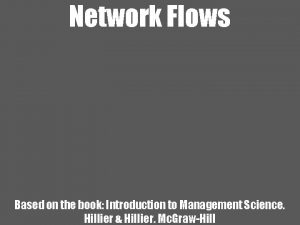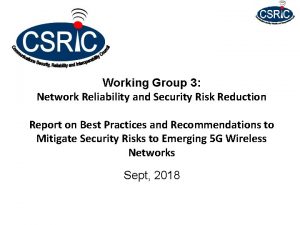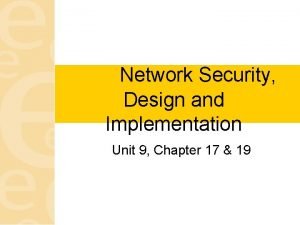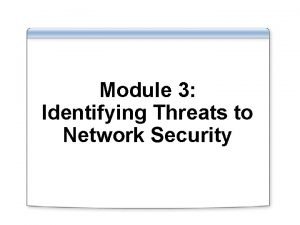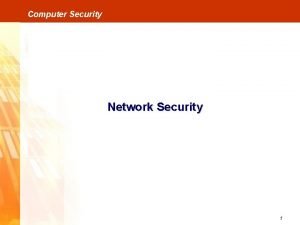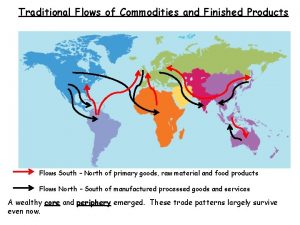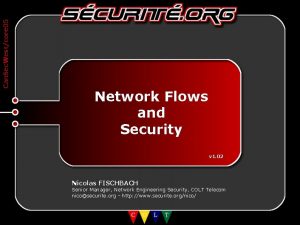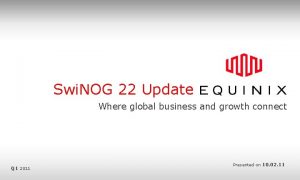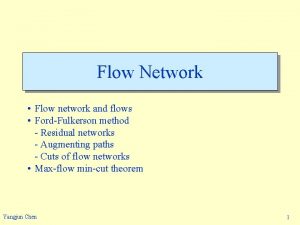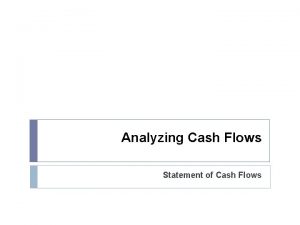Swi NOGX Network Flows and Security v 1

























- Slides: 25

Swi. NOG-X Network Flows and Security v 1. 01 Nicolas FISCHBACH Senior Manager, Network Engineering Security, COLT Telecom nico@securite. org - http: //www. securite. org/nico/

Swi. NOG-X Agenda ● The Enterprise Today ● Network Flows ● Netflow and NIDS ● Anomaly Detection ● Policy Violation Detection ● Peer-to-Peer ● Response and Forensics ● Conclusion 2

Swi. NOG-X The Enterprise Today ● Where’s my border ? ● WLANs, 3 G devices, etc. ● Remote VPN/maintenance access: employees, partners, vendors and customers ● Client-side attacks ● Malware/spyware relying on covert channels ● ● Usually one “flat” undocumented network: no internal filtering, no dedicated clients/servers LANs, etc. More and more (wannabe) power users 3

Swi. NOG-X The Enterprise Today ● Undocumented systems and applications ● Have you ever sniffed on a core switch’s SPAN port ? ● Do you really need (expensive) NIDS to detect worms ? ● More and more communications are encrypted: SSH, SSL, IPsec, etc (even internally) 4

Swi. NOG-X The Enterprise Today “Victims” since 2004 since 2003 “Proof of Concept” Automated Client side attack vs Direct exploitation “Noise” 2002 and before Exploit Time Po. C + Exploit Cross-platform/ + Worm ? extended research Vulnerability found Vulnerability “found” again Disclosure Patch available deployed Full/fixed patch “bad patch” 5

Swi. NOG-X Network Flows ● ● What are network flows and why are they so interesting? Netflow (Cisco terminology) used to be a routing technology which became a traffic accounting solution Used since years by Service Providers to detect and traceback DDo. S attacks and more recently for traffic engineering purposes In the enterprise network: – Network and application profiling, forensics, anomaly detection, policy violation, etc. – Netflow/NIDS: and/or ? Mix of macroscopic and microscopic views in high speed environments 6

« Executive floor » WLAN AP ap « IT floor » Internet access r fw cpe r controller Swi. NOG-X The Connected Enterprise s Internet r r cpe r s s External laptop Remote maintenance fw av as p Corporate Internet access ar Vendor Office Remote office/ Partners IP VPN Partner 7

Swi. NOG-X Netflow ● ● A flow is a set of packets with common characteristics within a given time frame and a given direction The seven netflow keys: – Source and destination IP address – Source and destination port (code for ICMP) – Layer 3 protocol – Type of Service – Ingress interface (“one way”) export (2055/udp) netflow cache r 8

Swi. NOG-X Netflow ● ● The following data are exported (Netflow v 5) – The 7 key fields – Bytes and packets count – Start and end time – Egress interface and next-hop – TCP flags (except on some HW/SW combination on multilayer switches) And you may also see the AS number and other fields depending on version and configuration ● IPFIX is based on Netflow v 9 ● Egress Netflow and per class sampling in recent IOSes 9

Swi. NOG-X Netflow ● The cache contains 64 k entries (default) ● A flow expires: ● ● – After 15 seconds of inactivity (default) – After 30 minutes of activity (default) – When the RST or FIN flag is set – If the cache is full Counting issues: aggregation and duplicates (a flow may be counted by multiple routers and long lasting flows may be “duplicated” in the database) Security issues: clear text, no checksum, can be spoofed (UDP) and possible Do. S (48 bytes per flow for a 32 bytes packet) 10

Swi. NOG-X Netflow ● ● Sampling – By default, no sampling: each flow entry is exported – Sampled: percentage of flows only (deterministic) – Random Sampled: like sampled, but randomized (statistically better) “Full netflow” is supported on/by most of the HW/SW, sampled and random sampled only on a subset Sampling reduces load and export size but “losses” data: – OK: DDo. S detection – NOK: Policy violation detection Avoid router-based aggregation 11

Swi. NOG-X Netflow ● General configuration router (config)# ip flow-export destination <server. IP> <port> router (config)# ip flow-export source loopback 0 router (config)# ip flow-export version 5 ● Tuning router (config)# ip flow-cache entries <1024 -524288> router (config)# ip flow-cache timeout active <1 -60> router (config)# ip flow-cache timeout inactive <10 -600> ● Display the local cache router# show ip cache flow 12

Swi. NOG-X Netflow ● “Full”/unsampled router (config)# interface x/y router (config-if)# ip route-cache flow ● Sampled router (config)# ip flow-sampling-mode packet-interval 100 router (config)# interface x/y router (config-if)# ip route-cache flow sampled ● Random Sampled router (config)# flow-sampler-map RSN (config-sampler)# mode random one-out-of 100 (config)# interface x/y (config-if)# flow-sampler RSN 13

Swi. NOG-X Netflow/NIDS ● ● Netflow is “header” only – Distributed and the network “speed” only has indirect impact – Often the header tells you enough: encrypted e-mails with the subject in clear text or who’s mailing whom =) NIDS may provide full packet dump – Centralized and performance linked to the network “speed” – Full dump or signature based dumps ? – PCAP-to-Netflow – May tell you the whole story (disk space requirements) 14

Swi. NOG-X Netflow/NIDS ● ● Let’s mix both: distributed routers sourcing Netflow and NIDS/sniffers in key locations! Decide how to configure your NIDS/sniffers: – PCAP-type packet sniffers – Standard ruleset – Very reduced and specific ruleset – How much data can you store and for how long ? ● Investigate ways of linking both solutions ● Storage (the older the less granular ? ) – Flat files – Database 15

Swi. NOG-X Anomaly Detection ● Discover your network – Enabling netflow will give you some insight on what your network actually carries : ) – After the shock and the first clean up round: – ● Sniff traffic in specific locations ● Introduce security driven network segmentation ● Build a complete baseline Update your network diagram 16

Swi. NOG-X Anomaly Detection ● ● Distributed Denial of Service – Fairly easy to spot: massive increase of flows towards a destination (IP/port) – Depending on your environment the delta may be so large that you don’t even require a baseline – You may also see some backscatter, even on an internal network Trojan horses – ● Well known or unexpected server ports (unless session reuse) Firewall policy validation – Unexpected inside/outside flow 17

Swi. NOG-X Anomaly Detection ● Worms – Old ones are easy to spot: they wildly scan the same /8, /16 or /24 or easy to code discovery pattern – New ones are looking for specific ports – Each variant may have a specific payload size – May scan BOGON space – The payload may be downloaded from specific, AV identified, websites – The source address is spoofed (but that’s less and less the case) 18

Swi. NOG-X Anomaly Detection ● ● Covert channels / Tunnels – Long flows while short ones are expected (lookups) – Symmetric vs asymmetric traffic (web surfing) – Large payloads instead of small ones – Think ICMP, DNS, HTTP(s) Scans – Slow: single flows (bottom. N) – Issue with bottom. N: long tail – Normal/Fast: large sum of small flows from and/or to an IP – Return packets (RST for TCP and ICMP Port Unreachable for UDP) 19

Swi. NOG-X Policy Violation Detection ● Workstation / server behaviour – Usually very “static” client/server communications – Who initiates the communication and to which destination ? – Office hours – New source/destination IPs/ports showing up – Tracking using DHCP logs, MAC address, physical switch port (SNMP) – Identify the “early” flows (auto-update and spyware) – ● After DHCP allocation or after login ● Flows after the initial communication Recurring flows (keyloggers) or flows towards the same destination but using various protocols (firewall piercing) 20

Swi. NOG-X Peer to Peer (P 2 P) ● ● ● Legacy P 2 P protocols often use fixed ports or ranges Sometimes (like with FTP) the data port is the control port +/-1 Recent P 2 P protocols have the session details in the payload: they can’t be tracked using netflow but the flow size may give you a hint 21

Swi. NOG-X Response ● ● Locate the source host – Requires the “netflow source” information (which router saw that flow) – Layer 3 and Layer 2 trace: identify the last layer 3 hop and then layer 2 trace or use previously SNMP polled MAC/port address Block the host – Port shutdown – ACLs – Blackhole route injection 22

Swi. NOG-X Forensics ● Netflow and dumps storage need to resolved first ● Clear post-mortem process ● ● Usual approach is to look for the flows and once identified extract the relevant dumps/logs In some environment only a couple of minutes/hours may be stored Legal/privacy issues Out-of-band network to push data and avoid multiaccounting 23

Swi. NOG-X Tools ● ● ● argus (http: //www. qosient. com/argus/) nfdump (http: //nfdump. sourceforge. net) with nfsen (http: //nfsen. sourceforge. net/) graphviz (http: //www. graphviz. org/): human eye is good at catching things, but the graphs become really complex ntop (http: //www. ntop. org/) Comprehensive list: tant/floma/software. html http: //www. switch. ch/tf- Commercial products 24

Swi. NOG-X Conclusion ● Netflow: macroscopic view ● NIDS/sniffer: microscopic view ● Network switches: layer 0/1 view (MAC address/port) ● Mix them while controlling – CAPEX/OPEX – Storage – Search/detection capabilities – Avoid impact on the network ● Active response ● Q&A (quarantine/active defense) ? 25
 Nogx
Nogx Wireless security in cryptography
Wireless security in cryptography Swi prolog portable
Swi prolog portable Prolog 예제
Prolog 예제 Visual prolog tutorial
Visual prolog tutorial Swi-prolog tutorial
Swi-prolog tutorial Visual prolog vs swi-prolog
Visual prolog vs swi-prolog Swi interrupt
Swi interrupt Swi prolog documentation
Swi prolog documentation Swi(standard work instructions)
Swi(standard work instructions) Swi prolog examples
Swi prolog examples Security security security
Security security security Osi security architecture in network security
Osi security architecture in network security Security guide to network security fundamentals
Security guide to network security fundamentals Electronic mail security in network security
Electronic mail security in network security Security guide to network security fundamentals
Security guide to network security fundamentals Security guide to network security fundamentals
Security guide to network security fundamentals Minimum cost flow
Minimum cost flow E commerce security policy
E commerce security policy Nist frame
Nist frame Network design and implementation
Network design and implementation Module 3: information and network security
Module 3: information and network security Cryptography and network security 6th edition
Cryptography and network security 6th edition Introduction to network security and cryptography
Introduction to network security and cryptography Number theory in cyber security
Number theory in cyber security Firewall base layer
Firewall base layer


